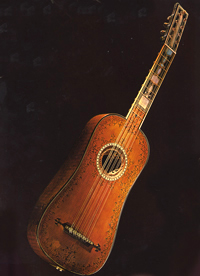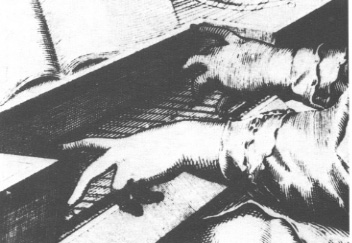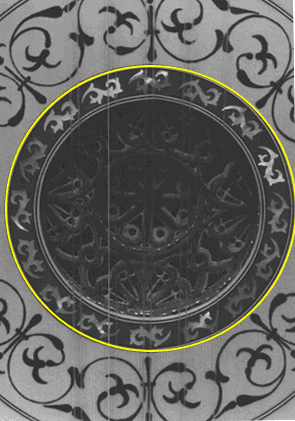AN APPROACH TO EARLY INSTRUMENTS

guitar Giovanni Tessler (Ancona, 1618)
Audio : Passacalles del 4° tono de Francisco Guerau on the Tessler guitar of 1618
drawn from the record for the Nice ncient Instruments Museum a disc containing among others the following works:
| on Giovanni Tessler guitar, Ancona 1618 : |
|---|
Francisco GUERAU (Poema Harmónico 1696) Gaspar SANZ (Instruccion de Música...1674)
|
on (René?) VOBOAM guitar, (Paris c.1650) : |
First suite : Prélude,
|
on Gérard DELEPLANQUE guitar, Lille 1771 : |
Aria and Variation.
|
Text by Michel Foussard about this recording:
The edition of this recording, which is presented as an illustration of Guitars, masterpieces from the collections of France requires some comments.
First, it is not an anthology of literature for guitar, whose extreme wealth, as the variety of styles and forms, for guitar solo or combined with voice and various instruments, can be summarized on both sides of a 33 rpm. At least we present here some mainstream without fear insert several very famous pieces that will give the listener to enjoy easier the new color they assume here on contemporary instruments, their invention.
[...] guitar Giovanni Tessler (1618) may originally had a longer neck; it was probably played at some point as chitarra battente; the current bridge replaces a large one of the nineteenth century. which masked some damage caused by worms. Guitar "Voboam" has a table by Theresse (Mirecourt, 1863), which, however, has probably retained the original pearl decoration, with a recent bridge (reconstitution for five double strings instead six single strings set by Theresse). Curiously, this guitar gives his most "baroque" sound according to the current taste of this recording, so it seems difficult to argue that Theresse has followed the original fan, likely reduced.
Guitar Deleplanque (1771) seems to have undergone any modification that adding perhaps XVIll ° c., a sixth- off string (with new head and corresponding pierced to the bridge) deleted thereafter.
[...]The special nature of this recording led us not to hide by artifices actual playing conditions. [...] As what we seek to subscribers disk Guitars, masterpieces from the collections of France, we felt good not to silence these small defects privacy, also easily rectifiable. The enchantment that can be born and found sounds, raise, we hope, the desire to go further in the redécouvertede guitar, his amazingly varied bill of his music still too little known.
M.F. Nice, April 1979 -
During therecording, the sound director particularly ensured that the respective stamps of four guitars we hear clearly reflected here. It is therefore necessary to initially establish a medium setting and not to change it during the listening.
AN HOMMAGE TO ANTOINE GEOFFROY-DECHAUME
The Langage of Harpsichord
A great movement for the harpsichord is a feature of the early twentieth century; it caused the updating of many texts on this instrument from its origins ...
Ancient texts had been very different if the piano was familiar to reviewers. They would then have given instructions emphasizing the obvious fundamental differences between two such dissimilar instruments and their respective techniques: one designed to showcase an instrument whose sounds have a fixed intensity, harpsichord; the other exclusively for an instrument whose sounds vary in intensity, the piano. The first is based on the diversity of duration of sounds, the second on the diversity of their intensity. There can be neither satisfactory nor permissible to adapt the technique of one of the two instruments to another,
The theory
Notes and rests, technical dampers.
Make speak sounds whose intensity is fixed, this is the role, that should be the goal of the harpsichordist. This language is mainly based on the durations of sounds. The principle is that every note played must be both preceded and followed by silence: these are the articulation silences. Mastery of these provides an infinite variety in the game of sound durations ...
If the articulation of the spoken language is made of mini-rests due to the consonants, the articulation of music requires also its mini silences, with the difference that the sound of an instrument is the same everywhere, and can not, so to speak, but producing a single vowel, it is necessary that the articulation silences be more varied than in speech, if we want to produce a kind of articularion intelligible and interesting. "Engramelle, La Tonotechnie ou l'art de noter les cylindres Paris, 1775, p. 24".
Harpsichordist (or organist) must have in relation to the phrasing of polyphony the same requirements as a conductor in relation to his musicians. It is unthinkable for a violinist to play without bowing, or a flutist without tonguing it is equally necessary to the keyboard, to make audible the independence of each voice, hence the importance of the work of all piece by separate parts.
ANTOINE GEOFFROY-DECHAUME AND THE LANGUAGE OF HARPSICHORD
Text by Jacqueline Ritchie and Jean-Joël Duhot
The father of Antoine Geoffroy-Dechaume, who was a painter, had a friend Arnold Dolmetsch, who at the time worked at Gaveau. Barely seven years old, the young Antoine hears Bach in unequal notes. He then studied organ, according to a tradition quite different: that of César Franck school. However, he does not forget the lesson of Dolmetsch: towards fifteen he began to play the continuo in a concert society (Ars Musica) where his competence was quickly recognized. The conductor asks him when he hesitates before a passage. Gradually Antoine Geoffroy-Dechaume realizes that Dolmetsch did not find anything, he has not yet gone far enough. He goes on alone research that made him a great specialist in early music. People do consult him, he is asked to transcribe in modern notation works of Baroque music, to make them accessible to musicians. Thereby preparing the Eléments by JF Rebel for Opera Orchestra, under the direction of Roger Désormières, Hippolyte et Aricie conducted in concert version by Pierre Boulez. At a time when the baroque ensembles are still unthinkable he makes possible a musical approach whose testimonials attest to a surprising fidelity.
In 1964 he published a small book of 150 pages that contains the essential encyclopedic knowledge: Les Secrets de la musique ancienne (Fasquelle, 2nd Edition 77). Antoine Geoffroy-Dechaume has long been one bothers recalling that our traditions of interpretation do not allow further back than the nineteenth century, that beyond the musical signs no longer have the same meaning and the style, forgotten, has to be rediscovered in a process that involves patient musicianship, intelligence and the study of the era treaties.
Antoine Geoffroy-Dechaume is probably the man who knows best early music, but it's a musician before being a scientist. He played as a soloist and in chamber music and continuoist in France and abroad. He received a Grand Prix du Disque in 1967 for a record dedicated to Louis Couperin and Jacques Champion de Chambonnières, His interpretations and teachings have had a decisive influence that escapes no one who now practice early music.
Antoine Geoffroy-Dechaume welcomes us and tells us of his treatise:
Q. Antoine Geoffroy-Dechaume, you are the author of a harpsichord method soon to be published in the Van De Velde editions. It is quite interesting since you are advocating the use of a completely unknown or little-known technology today. What is this technique?
A.G.D. This is in fact a keyboard technique was the technique itself. Only when the musicians, harpsichord or organ players, knew they did not have to worry, by playing the sound of an instrument that they could not change anything by their touch. In contrast to the pianist who is himself fully responsible for the sound quality of a given instrument. The pianist makes the piano sound.
Q. Can we then say that the piano required a new approach to the keyboard, which condemned at the same time the old technique of playing?
A.G.D. Exactly. This technique remains unchanged over the centuries, whether organ or harpsichord. The appearance of the piano playing was fatal and there has disappeared. Today, it remains no trace, at least officially.
Q. What is the principle?
A.G.D. The principle is control by the fingers alone, with actual durations of sounds to be able to articulate them musically. Articulations, mini-silences between sounds, make the pronunciation of the musical language - I speak to flutists - while at the piano we think above all the noise impact, intensity of sound.
Q What is the main characteristic of this technique and what do you call control of rests?
A.G.D.To give the possibility to the harpsichord and to the damper of the organ valves to instantly mute the sound would allow this control of mini-silences. But what happens in reality when a succession of quick notes are played as piano technique? They will or may be linked, lightweight, loose or pitted, but all identical in length - hence a mechanical game without any expressive possibility.
harpsichord fingers alone: ![]()
varied silences , "inequal" notes
piano legato modern playing : ![]()
sounds are then "glued"
piano détaché from the wrist : ![]()
the sounds are "stitched" but identical
Instead, the real control of these mini-silences by the appropriate technique allows each note its individuality 'so to say. And I come back to the flute: is not this the variety of licks that allows musical expression? Keyboard fingers get these "licks' that is to say the equivalent of the "échappement" of the keys - and this is the main feature of the technique,
Q What do you call "échappement" of the keys?
A.G.D. There are two ways to exit the keyboard : either raise fingers vertically above the keyboard, or take them back to the palm of the hand. The latter way is the appropriate in this case. It alone makes this hand both soft and lightweight 'as dead' asked by Rameau. Finally it alone explains all the old fingerings, they explain in their turn the living articulations of the works of the past, since the virginalists to the musicians of the eighteenth century: Couperin, Rameau, Bach, Scarlatti ...

Virginal , Londres, 1651 ; showing "échappement"
Q. You put in fact the harpsichordists and organists today in a delicate situation. You show that the only technique you talk helps to give the music that corresponds to it, its phrasing, its expression, its real accent, but it's a complete technical revolution! We must relearn everything.
A.G.D. I stop you when you say, 'music that corresponds to it. I do not agree at all with the word "music " because it is to the instrument you have to think. Does not this technique give to instruments supposed expressionless the possibility to become expressive? It gives us actually new instruments. As to relearn everything, it is a fact.
Q . The harpsichordists who go ahead with their technique therefore can not give it up to try to acquire another they do not know how to do.
A.G.D. They have good reason in this case, if they do not see the point.
Q. The ideal is therefore directly form clavecinistes without trying to recycle musicians who have trained pianists. Have you students who begin?
AG.D. Yes, and very young in particular, between six and ten years. They understand very natural expression that can give proper "toucher" in the harpsichord.

Luthfi Becker baroque guitar (1980)